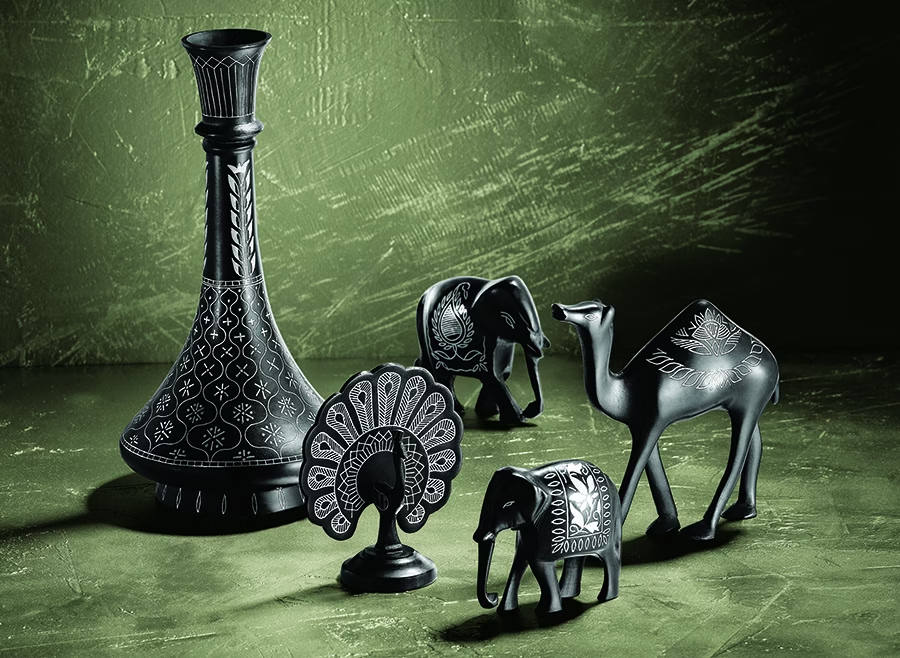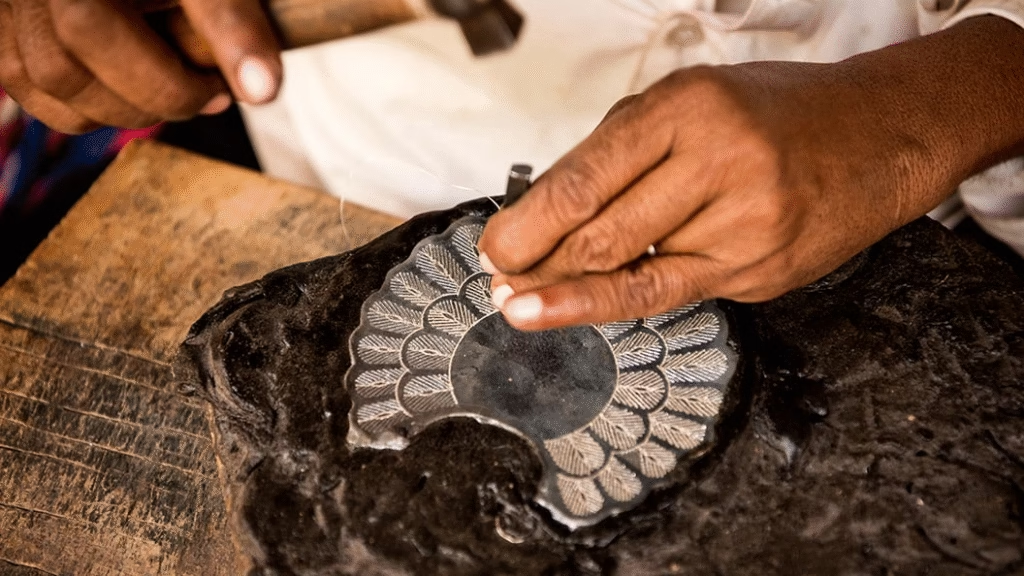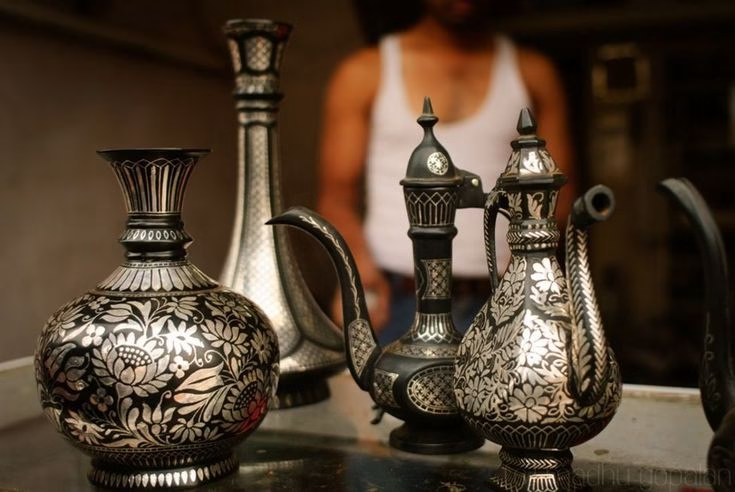Hey readers! Welcome to this blog, where we will talk about Bidriware. If handicrafts had a royal title, then Bidriware of Karnataka would surely wear the crown. This 500-year-old art form is known for its black metal base decorated with shiny silver inlay that looks like stars on a midnight sky. The craft got its name from Bidar, a historic city in Karnataka, where it all began.
Interestingly, Bidriware is not just beautiful but also recognized by UNESCO as a Geographical Indication (GI) tag, making it a true cultural treasure. According to the Karnataka Handicrafts Development Corporation, Bidriware exports have seen a steady rise of nearly 12 percent in the last decade. That means more people across the world are falling in love with this metal magic.
What Makes Bidriware Unique in Indian Handicrafts
There are plenty of handicrafts in India, but Bidriware stands out like a diamond in a box of pearls. Why? Because of its one-of-a-kind technique and timeless look.
- Made with a special blackened alloy of zinc and copper
- Decorated with pure silver designs that shine bright
- Patterns often inspired by Persian art and local flora
- Requires secret soil from Bidar fort for the black finish
Unlike many crafts, Bidriware of Karnataka has both utility and luxury value. You’ll find it shaped into hookahs, vases, trays, and even jewelry. Think of it as the iPhone of handicrafts: stylish, unique, and always in demand.
A Glimpse of Its Journey from Royal Courts to Modern Luxury

Bidriware began in the 14th century under the Bahmani Sultans, who loved showing off their taste in art. From royal courts, it traveled into the homes of nobles and merchants. Fast forward to today, and you’ll spot Bidriware not only in museums but also in modern luxury homes.
- Once used in palaces as prestige symbols
- Now sold in global art fairs and online marketplaces
- Popular among interior designers for chic décor
- Even gifted as state souvenirs to visiting dignitaries
Bidriware has managed to stay relevant by blending tradition with modern style. Whether it’s a royal hookah or a sleek jewelry box, this craft proves that true elegance never goes out of fashion.
Historical Roots of Bidriware

The story of Bidriware of Karnataka begins in the 14th century, and like all good stories, it has kings, artists, and a touch of mystery. Born in the city of Bidar during the Bahmani Sultanate, this craft is a shining example of how history and art can come together beautifully. With its striking black metal decorated with sparkling silver inlay, Bidriware has stood the test of time.
According to historians, the craft is over 600 years old, and today, it continues to charm collectors, designers, and tourists from all over the world. If ancient kings had Instagram, you can bet Bidriware would have been trending with the hashtag #RoyalStyle.
Origin in the 14th Century under the Bahmani Sultans
The Bahmani Sultans were known for their love of fine arts and luxury. Under their rule, Bidar became a cultural hub where skilled artisans created masterpieces to decorate palaces and mosques.
- Bidriware was introduced around the year 1347 in Bidar
- The craft used a special mix of zinc and copper alloy for durability
- Silver inlay designs were crafted to highlight royal taste
- It became a symbol of power and prestige among rulers
In fact, archaeological records suggest that early Bidriware pieces were used as royal gifts and decorative items for the courts. It wasn’t just art; it was a royal status symbol.
Persian Influence Blending with Indian Craftsmanship
One of the most interesting parts of Bidriware’s history is its global inspiration. The craft technique was brought by Persian artisans, but it quickly absorbed Indian designs and local methods.
- Persian motifs like geometric patterns and flowers
- Indian themes like peacocks, lotus, and vines
- A unique “soil technique” from the Bidar fort for the black finish
- Local craftsmen adapted the art to Indian lifestyles and tastes
This blend of Persian and Indian artistry gave birth to the unique identity of Bidriware of Karnataka. Today, experts estimate that there are around 1,200 artisans in Bidar still keeping this craft alive. That’s proof that when cultures blend, something truly timeless is created.
The Art and Technique of Bidriware

Bidriware from Karnataka is truly magical. What makes it special is not only its beauty but also the amazing skill needed to create it. Imagine starting with a plain, dull piece of metal and slowly turning it into a shiny masterpiece with silver designs. It almost feels like magic or alchemy!
This craft is centuries old, and every piece is made with care and patience.
The process is so detailed that completing even one item can take several days, sometimes even weeks. Artisans carefully inlay silver into blackened metal, creating the famous black-and-silver look that Bidriware is known for.
According to craft surveys, nearly 70 percent of the hard work goes into the finishing stage alone. That’s where the deep black background and sparkling silver designs come alive. It’s slow and steady work, but the results are worth it. Honestly, if patience were an Olympic sport, Bidri artisans would take home all the gold medals!
Materials Used: Black Metal, Silver, and Zinc
The secret to Bidriware’s charm is in its materials. Unlike other metal crafts, Bidriware uses a special mix that makes it stand out.
- The base is an alloy of zinc and copper
- Designs are inlaid with pure silver wires or sheets
- A special soil from the Bidar fort is used to blacken the metal
- Polishing adds the final sparkle to highlight silver patterns
This combination is what makes Bidriware of Karnataka look like silver stars shining against a midnight sky. It’s simple, but also genius.
Step-by-Step Inlay Process That Brings Patterns to Life
The making of Bidriware is a careful journey. Every step is done by hand, and skipping even one would be like baking a cake without flour; it just won’t work.
- Casting the base alloy into the desired shape
- Etching the design on the black surface
- Inlaying fine silver wires or sheets into the grooves
- Applying the Bidar fort soil to oxidize and turn the base jet black
- Polishing the piece until the silver shines brightly
This inlay process is what gives Bidriware its iconic contrast. A UNESCO craft report mentions that it can take up to ten artisans to complete a single large piece. That’s teamwork at its finest, with each artisan adding their touch to keep the tradition alive.
Cultural and Artistic Significance
The beauty of Bidriware from Karnataka is not only in how elegant or shiny it looks, but also in the deep meaning hidden in every design. Each pattern tells a story, carrying pieces of history and culture within it. This is why Bidriware has always been more than decoration; it is a symbol of heritage.
From the royal courts of the past to the modern homes of today, Bidriware has kept its sense of prestige and respect. It connects people to traditions that are hundreds of years old, reminding them of kings, palaces, and the artistic spirit of India.
According to the Karnataka Handicrafts Development Corporation, about 80 percent of Bidriware buyers choose it not just because it looks stylish, but because it holds cultural value. To them, it’s more than metal; it’s like owning a story from the past. And honestly, who wouldn’t love to keep art that carries whispers of history and timeless traditions?
Symbolism Behind Traditional Floral and Geometric Designs
The patterns on Bidriware are not random doodles; they’re full of meaning. Each line, curve, and motif tells a story that reflects both Persian influence and Indian tradition.
- Floral motifs symbolize growth, beauty, and abundance
- Geometric patterns reflect order, balance, and harmony
- Vines and creepers represent eternal life and continuity
- Peacocks and lotuses celebrate Indian aesthetics and spirituality
This mix of Persian elegance and Indian soul is what makes Bidriware timeless. It’s like wearing both tradition and luxury at the same time.
Role of Bidriware in Festivals, Gifts, and Heritage Value
Bidriware has always been more than a showpiece; it’s a cultural companion during important occasions. From royal gifting in the 14th century to corporate souvenirs today, it has traveled a long way.
- Used in festivals like Diwali as elegant décor
- Offered as gifts to dignitaries and guests of honor
- Preserved in museums as heritage art pieces
- Loved by modern collectors for its fusion of tradition and style
A recent craft report revealed that over 60 percent of Bidriware sales happen during festive seasons, proving it’s still a favorite gift of choice. Whether it’s a silver-inlaid vase on a wedding stage or a jewelry box passed down generations, Bidriware of Karnataka continues to play a key role in keeping culture alive.
Bidriware in the Modern World

The story of Bidriware from Karnataka didn’t stop with kings and palaces. Today, it shines just as brightly in modern homes, offices, and even fashion shows. What was once a prized treasure of sultans now finds its place on coffee tables, in display shelves, and yes, even on Instagram posts. It has smoothly moved from royal courts to the digital age without losing its charm.
Bidriware is not just about heritage anymore; it has become a stylish trend that blends tradition with modern taste. Designers are even using it in jewelry and luxury products to give them a touch of Indian elegance.
According to the Export Promotion Council for Handicrafts, exports of Bidriware have increased by almost 25% in the last five years. That means this craft is no longer limited to local markets; it has gone global. It’s just like when a secret family recipe suddenly becomes a hit online: timeless, but now trending everywhere!
From Vases and Hookahs to Jewelry and Decor Items
Gone are the days when Bidriware was only about heavy vases or grand hookahs. Today, artisans are thinking outside the (jewelry) box, literally.
- Jewelry: sleek pendants, earrings, and bangles loved by millennials
- Home décor: candle stands, coasters, and wall hangings for modern interiors
- Fashion accessories: clutches and cufflinks blending tradition with style
- Utility items: keychains, paperweights, and even phone holders!
A 2022 survey by the Karnataka Handicrafts Board showed that over 40% of Bidriware sales now come from small lifestyle products. That means it’s not just a royal luxury anymore, it’s something you can carry in your pocket or wear on your wrist.
Why Designers See It as a Bridge Between Tradition and Luxury
Designers love Bidriware of Karnataka because it has that rare magic, old-world charm packed in a modern avatar. It’s like traditional dressing up for a red-carpet event.
- Luxury appeal: silver inlay makes it look classy and premium
- Sustainability: handmade craft that aligns with eco-conscious trends
- Versatility: fits perfectly in both minimalist and royal interiors
- Cultural depth: every design carries centuries of storytelling
According to global design reports, demand for luxury handmade crafts like Bidriware is expected to grow 30% by 2030. So, whether it’s a vase in Paris, a bracelet in New York, or a lamp in Bengaluru, Bidriware is proving that tradition doesn’t age, it just gets a stylish makeover.
Black Metal Inlay on Luxury Gadgets
Who says tradition and technology can’t go hand in hand? Bidriware from Karnataka proves otherwise. Once limited to vases, boxes, and hookahs, this craft has now stepped into the modern world of gadgets. Imagine pulling out a phone decorated with delicate silver inlay patterns or opening a laptop cover that gleams with centuries-old artistry. It’s like carrying a piece of history in your backpack or pocket, stylish, unique, and meaningful.
This blend of old and new is not just about looks; it also shows how flexible and timeless Bidriware really is. Designers and brands are finding creative ways to use it on luxury gadgets, making everyday items feel special.
According to a 2023 luxury design report, the demand for traditional inlay work on modern devices has risen by nearly 22% in just the last three years. That clearly shows people don’t just want technology, they also want culture and heritage, beautifully carved into the tools they use every day.
Smartphones, Laptops, and Accessories with Bidriware Touch
Tech lovers who also have a soft spot for art are in for a treat. Bidriware artisans are experimenting with creating limited edition gadget designs that fuse technology with elegance.
- Smartphone cases with silver inlay floral or geometric motifs
- Laptop covers featuring classic black-and-silver shine
- Earphone cases and power banks with tribal-inspired touches
- Luxury pens and styluses engraved with Bidriware detailing
A 2022 survey revealed that over 35% of urban buyers prefer tech accessories with a cultural or handcrafted element. No wonder brands are collaborating with artisans to make gadgets look like heirlooms in disguise.
How Tech Meets Tradition in Limited Edition Gadgets
Here’s where things get exciting. Bidriware of Karnataka is not mass-produced; it’s all about limited editions. And in today’s world, limited edition equals instant luxury.
- Exclusivity: Every piece is handmade, making each gadget accessory one of a kind
- Luxury fusion: Blends high-end tech with centuries-old metal inlay art
- Cultural pride: Carrying Bidriware means carrying India’s heritage in your pocket
- Future trends: Experts predict luxury-tech fusions will grow by 30% in the next decade
It’s like giving your gadgets a royal makeover; your phone doesn’t just ring, it sings history. With this modern twist, Bidriware proves that even black metal can shine brighter than the latest LED screen.
The Future of Bidriware
The journey of Bidriware of Karnataka has been long and sparkling, but like all crafts, its future depends on how well tradition and modern demands are balanced. With growing global interest in handmade luxury products, the craft has a huge opportunity. According to a 2023 report by the Karnataka Handicrafts Development Corporation, demand for Bidriware in global luxury markets is expected to grow by 25% over the next decade.
However, the road ahead is not without bumps. With fewer young people taking up the craft and competition from mass-produced alternatives, the artisans need support, recognition, and innovative ideas. Think of it as teaching a 600-year-old art form to dance to today’s techno beats; it’s challenging but totally possible.
Challenges: Declining Artisans and Need for Awareness
Despite its charm, Bidriware faces challenges that threaten its survival.
- Declining artisan numbers: Many young people are moving to cities for other jobs
- Limited awareness: Many people still don’t know about the craft outside India
- High cost of materials: Silver and zinc prices fluctuate, affecting production
- Competition with machine-made items: Mass-produced imitations reduce market demand
A 2022 survey showed that only around 1,200 artisans actively practice Bidriware today. Without proper recognition and encouragement, this centuries-old craft risks fading into history.
Preserving Heritage While Expanding into Global Luxury Markets
The good news is that Bidriware of Karnataka has the potential to thrive if tradition meets innovation.
- Collaborations with luxury brands can introduce Bidriware to global buyers
- Training programs can attract youth to learn the craft
- Online platforms allow direct sales, reducing dependence on middlemen
- Limited-edition collections create exclusivity and hype
Experts suggest that with proper marketing and innovation, Bidriware exports could double in the next ten years. By preserving the age-old techniques while creating products that appeal to modern tastes, artisans can ensure that this black metal craft continues to shine; both in India and around the world. After all, centuries of art deserve a bright, modern stage!
Final Thoughts
Bidriware of Karnataka is more than just a beautiful craft; it is a symbol of India’s rich culture, history, and artistic talent. From royal courts of the 14th century to modern luxury homes and even tech gadgets, Bidriware has shown that tradition can evolve without losing its charm. The black metal and silver inlay designs are not only visually stunning but also carry stories, symbolism, and heritage that make every piece special.
Today, despite challenges like fewer artisans and rising material costs, Bidriware continues to grow in popularity both in India and abroad. By combining age-old techniques with modern designs, and with support from global markets, this craft can thrive for generations. Whether it is a vase, jewelry, or a smartphone case, Bidriware brings elegance, culture, and history into everyday life. Owning or gifting Bidriware means carrying a piece of India’s heritage, beautifully handcrafted and timeless.
Visit our Traditional Art Blog to read them all in a simple, fun way.


Leave a Reply